Llanuwchllyn is a village situated near the southern end of Bala Lake (Llyn Tegid), in the ancient County of Merionethshire, and is the home station of the Bala Lake Railway. The men of the village who fell during the Great War are commemorated on two tablets which are located on the gateway into Llanuwchllyn Cemetery. The memorial was unveiled on 3 September 1922, and commemorated the 20 men of the village who gave their lives, some of whom are also commemorated on the Bala memorial.
The Great War, 1914-1918
Ernest Ivor Daniels, Sapper, 229643, Royal Engineers. Ernest was born on 9 February 1890, the son of Robert and Margaret Daniels, of Ivy House, Llanuwchllyn. By 1906 he was living Maida Vale, and worked as a Clerk for the Great Western Railway in their Accounts Office at Paddington. He married Lizzie Dora Pritchard, a Domestic Servant from Abererch, in Brentford on 27 February 1913, and the couple lived at 14 Thorngate Road, Maida Hill. Ernest enlisted into the Royal Engineers at Paddington on 9 December 1915 and was posted to the 98th Light Railway Crew Company. After Ernest had completed his training, he was posted to Egypt, and embarked at Southampton aboard the SS Osmanieh, a requisitioned passenger liner, on 17 December 1917. The ship was carrying soldiers and medical personnel and set a course for Alexandria with a stopover in the southern Italian port of Taranto, which was reached on 28 December. She then headed to Alexandria on 31 December 1917 and was heading towards the entrance to the harbour when she struck a mine which had been laid by the German submarine UC-34, and sank in just over five minutes with the loss of 209 lives. Ernest was among those drowned in the sinking. He was 27 years old and is commemorated on the Chatby Memorial, Alexandria, Egypt.
Robert Edward Davies, Private, 61020, Royal Welsh Fusiliers. Robert was the son of Henry and Margaret Davies, of Hafodyrwyn, Llanuwchllyn. He enlisted at Dolgellau into the Royal Welsh Fusiliers and after completing his training, was posted to France at some time in 1917, joining the 19th Battalion, Royal Welsh Fusiliers. The battalion was attached to 119 Brigade, 40th (Bantam) Division, and Robert possibly joined up with it before the Division took part in the Battle of Bourlon Wood from 23 November. The Division suffered terrible casualties during the fighting in the wood over the coming days, before being relieved on the night of 25/26 November. The Division then went into reserve at Bienvillers before returning to the front at the beginning of December, taking over a section of the line at Bullecourt, and the various battalions of the Division then began their usual spell of trench rotation over the coming weeks. Robert was killed in action at Bullecourt during a routing spell in the trenches, just prior to the 19th RWF being relieved on 3 February 1918. He was 23 years old and is buried in St. Leger British Cemetery, France.
Arthur Edwards, Private, 55334, Royal Welsh Fusiliers. Arthur was the son of Edward and Eliza Edwards, of Tyddyn’ronnen, Llanuwchllyn. He was apprenticed to Thomas Jones, Chemist, at Oswestry prior to the war. Arthur enlisted at Oswestry into the Royal Welsh Fusiliers in May 1916, and after completing his training, was posted to France at some time around the winter of 1916/17, before being posted to the 14th Battalion, Royal Welsh Fusiliers, which was at Ypres, attached to 113 Brigade, 38th (Welsh) Division. The Division was in the Canal Bank Sector, north of Ypres, and its various infantry battalions was carrying out the normal routine of rotation in the trenches. On 13 February 1917 the 14th RWF moved into the front line to begin another tour. Early in the morning of 18 February 1917, the battalion sent out a trench raiding party, under Lieutenant Ormsby, comprising of four officers, three NCO’s and 145 other ranks. Among the party was Arthur, who was probably taking part in his first trench raid. The men succeeded in entering the German trenches, but the Germans brought a heavy barrage of trench mortar rounds down upon them, forcing the raiding party to withdraw. Casualties were already heavy, and more men were killed and wounded as the party made its way back to the safety of their own lines, including Lieutenant Ormsby, who was mortally wounded. Arthur was also among those killed as the party withdrew. The 22-year-old is buried in Bard Cottage Cemetery, Belgium.
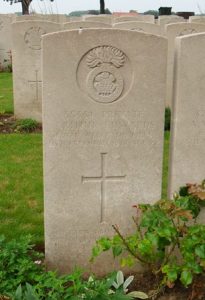
David Edwards, Private, 3386, Australian Infantry. David was the son of Rowland and Elizabeth Edwards, of Tremgarth, Llanuwchllyn. He had served with the 7th Battalion, Royal Welsh Fusiliers prior to emigrating to Australia, where he found work as a shop assistant at Adelaide. David enlisted at Adelaide into the 9th Reinforcements of the 48th Battalion, Australian Infantry on 9 November 1916, and embarked at Adelaide for England aboard HMAT Seang Bee on 10 February 1917. On 2 May 1917 David disembarked at Devonport and marched into camp at Codford. On 23 May 1917 he was posted to France, and on 12 August 1917 was taken on strength by the 48th Battalion at Ypres. The battalion was attached to the 12th Brigade, 4th Australian Division, and had taken a pounding during the Battle of Bullecourt. David joined up with the battalion in the support line at Cabin Hill, near Ypres. The Third Battle of Ypres was raging, and the Australians had been moved to Ypres to take part in the mighty battle. During September the Australians took part in heavy fighting around the Menin Road, and then at Polygon Wood on 26 September, where the Australians attacks proved successful but very costly. On 12 October 1917, the 12th Brigade was assigned to protect the 3rd Australian Division’s flank during the assault to take the village of Passchendaele, but although the village was entered, the Australians were eventually beaten back after suffering terrible casualties. David was posted as missing during the terrible fighting around the village during the day. Despite extensive enquiries, nothing could be found of his fate, so David was adjudged by a Court of Enquiry to have been killed in action at Passchendaele on 12 October 1917, aged 36. During battlefield clearance work after the war, David’s body was found among a number of other Australian remains. He was identified by documents in the pockets of his tunic, and was buried in Passchendaele New British Cemetery, Belgium on 17 April 1920.
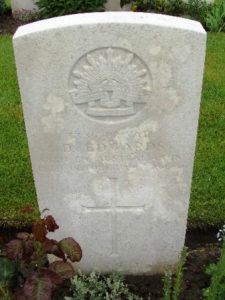
Robert John Evans, Private, 21290, Royal Welsh Fusiliers. Robert was the son of Edward and Ellen Evans, of Cefnrhos, Llanuwchllyn. He was a farm labourer at Gefnymeiroh prior to the war. Robert enlisted at Bala into the 14th Battalion, Royal Welsh Fusiliers soon after the outbreak of war. The battalion was raised at Llandudno by the Welsh National Executive Committee, joining 128 Brigade, 43rd (Welsh) Division and trained in North Wales before moving to Winchester in the summer of 1915, where the formation became renumbered 113 Brigade, 38th (Welsh) Division. The Division moved to France on 2 December 1915 and moved to the Nursery Sector near Fleurbaix for trench initiation alongside the Guards Division. The Division then held a sector of the line near Cuinchy before marching south to the Somme sector in June 1916 to take part in the assault on Mametz Wood. The first attack on the wood was launched on a two-battalion front on 7 July, but failed, and the Divisional Commander, Sir Ivor Philipps, was replaced before the Division attacked again on a two Brigade front on 10 July 1916. Robert was badly wounded during the fighting in the wood and was evacuated to Hospital, before being brought back to Fazakerley Hospital in Liverpool for treatment. He died of his wounds there on 8 September 1916, aged 22. His remains were brought home for burial in Llanuwchllyn Cemetery.
John Howell Griffiths, Private, 53287, Cheshire Regiment. John was the son of Thomas and Jane Griffiths, of The Library, Llanuwchllyn. He worked as a Lampman for the Great Western Railway at Birkenhead prior to enlisting at Birkenhead into the Army on 19 May 1916, and was placed on the Reserve. John was mobilised on 29 December 1916 and posted to the 14th Battalion, Training Reserve. On 20 May 1917 he was posted to the King’s Shropshire Light Infantry, embarking for France. On 11 June 1917 John was transferred to the 2nd Battalion, Welsh Regiment, which was attached to 3 Brigade, 1st Division. John then attended a course at Le Touquet before re-joining the 2nd Welsh just prior to the 1st Division taking part in the latter stages of the Passchendaele offensive. John was wounded in the hand at Passchendaele and admitted to the 24th General Hospital at Étaples for treatment before returning to England. Upon recovering, he was posted to the Welsh Regiment Depot at Cardiff, before he returned to France on 30 March 1918, and was transferred to the 11th Battalion, Cheshire Regiment. The Battalion was attached to 75 Brigade, 25th Division, and had just moved to Flanders, following action on the Somme, during the German Spring offensive. From 9 April 1918 the Division became caught up in heavy fighting when the Germans launched the second phase of their offensive, along the Lys Valley. The 11th Cheshire’s were holding the line south of Ploegsteert Wood and at dawn on 10 April came under heavy artillery fire, and soon the battalion found Germans to the rear, forcing it to withdraw. In the village of Ploegsteert the battalion came under fire from German machine-guns, and with the entire line under attack, heavy fighting raged throughout the day. John was killed in action during the fighting around Ploegsteert that day, 10 April 1918. The 20-year-old has no known grave and is commemorated on the Ploegsteert Memorial, Belgium. His brother, Robert, had died in Egypt in 1916.
Robert Oliver Griffiths, Private, 4315, Royal Welsh Fusiliers. Robert was the son of Thomas and Jane Griffiths, of The Library, Llanuwchllyn. He worked as a Mate on a Traction Engine prior to enlisting into the 7th Battalion, Royal Welsh Fusiliers at Blaenau Ffestiniog on 24 February 1916, and was posted to Park Hall, Oswestry. On 3 July 1916 Robert embarked at Devonport for Egypt, and upon arrival joined the 1/7th Battalion, Royal Welsh Fusiliers on 19 July. The Battalion was attached to 158 Brigade, 53rd (Welsh) Division and was on the Suez Canal, as part of the EEF, following service in Gallipoli. Robert had only been in Egypt for five weeks when he became ill, and was taken to the 26th Casualty Clearing Station at Kantara, where he died of dysentery on 4 September 1916, aged 22. He is buried in Kantara War Memorial Cemetery, Egypt.
David Thomas Jones, Private, 61078, Royal Welsh Fusiliers. David was the son of David and Elizabeth Jones, of Tyn-Y-Cae, Cynllwyd, Llanuwchllyn. He married Grace Jones, of Brynmoel, Bala, early in 1917. David enlisted at Dolgellau into the Royal Welsh Fusiliers and was posted to France in the late Summer of 1917, joining the 2nd Battalion, Royal Welsh Fusiliers, which was attached to 19 Brigade, 33rd Division. He joined the Division at Ypres, where it was taking part in the terrible fighting for Passchendaele Ridge, and spent much of December on Passchendaele Ridge. On the morning of 5 January 1918, the 2nd RWF relieved the 5th Border Regiment in the line at Passchendaele to begin another routine tour. David was killed in action here during a relatively peaceful day, on 8 January 1918, aged 27. He has no known grave and is commemorated on the Tyne Cot Memorial, Belgium.
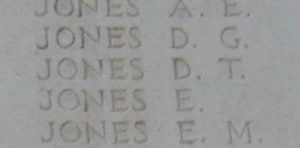
David Thomas Jones, Private, 203970, Royal Welsh Fusiliers. David was the son of Edward and Ann Jones, of Glanllyn Farmhouse, Llanuwchllyn. He worked as a Cowman at Berthlafar Farm prior to the war. David was conscripted into the army, but his employer took the case to the Military Appeals Tribunal, as he was a farmworker, but the Court ruled against his appeal and that of one other man, William Jones, a Shepherd, as there were five men working on the farm and they could be spared. As a result he enlisted into the 4th Battalion, Royal Welsh Fusiliers at Dolgellau on 21 February 1917. On 16 August 1917 David was posted to France, to No 5 Infantry Base Depot and on 30 August was posted to the 9th Battalion, Royal Welsh Fusiliers, which was in the Ypres Salient, attached to 58 Brigade, 19th (Western) Division. David would have seen his first major action during the Battle of the Menin Road soon afterwards, and during the Divisions actions during the fighting at Polygon Wood, Broodeseinde, Poelcapelle and Passchendaele Village. The Division then moved south, and from 21 March 1918 got caught up in the German Spring Offensive, taking part in heavy fighting as it withdrew over the coming days. David was badly wounded during the opening day of the offensive, on 21 March, and was evacuated to 48 Casualty Clearing Station for treatment. He was then transferred to the 7th Canadian General Hospital, at Étaples, where he died of his wounds on 15 April 1918, aged 20. He is buried in Étaples Military Cemetery, France.
Morris John Jones, Private, 26333, Lancashire Fusiliers. Morris was born in Llanuwchllyn in 1892, the illegitimate son of Elizabeth Jones, of Aran View. He gained work as a farm labourer at Tynant, Tynllwyd, Llanuwchllyn. In 1896 his mother married John Owen Edwards, and later moved to 29, Mount Grove, Borough Road, Birkenhead. Morris enlisted at Liverpool into the 18th Battalion, Lancashire Fusiliers. The battalion was raised at Bury on 13 January 1915, moving to Masham, Yorkshire, where it joined 104 Brigade, 35th Division. The Division moved to France in late January and early February 1916. It took over the trenches at Rue du Bois and remained there until moving to the Somme in the first week of July and on 20 July moved into the front near Bernafay Wood. Morris was killed in action here whilst fighting at Dublin Trench on 24 July 1916. The 24-year-old has no known grave and is commemorated on the Thiepval Memorial, France.
Hugh ap Gwilym Morris, Captain, Royal Army Medical Corps. Hugh was born in 1884, the son of William and Caroline Morris, Agent for the Glanllyn Estate, Bala, North Wales. Hugh was educated at Llandovery from 1896 until 1904, where he was a prefect, and described as a good cricketer. After leaving Llandovery, Hugh went up to Oxford, where he graduated B.A. in 1908. While at Oxford he was a ‘reserve’ Blue at rugby. He also played rugby for several London Clubs including London Hospital. In 1911 Hugh married Elsie Taplin and completed his studies at London hospital Medical College, where he qualified M.B. in 1914. At the outbreak of War, Hugh enlisted in the Army and was commissioned in the R.A.M.C. in January 1915. By now he had two children, and on 25 July 1915 he arrived in France with the 54th Field Ambulance Unit, which was attached to the 18th (Eastern) Division. In 1916 Hugh was promoted to Captain. By now the Division was on the Somme, and were in the thick of the Battle of Bazentin Ridge. On 14 July 1916 Hugh was killed outright while attempting to save the life of a wounded soldier, under circumstances for which he was recommended by his Commanding Officer for the award of the Victoria Cross, but sadly this was not granted. Hugh was 32 years old, and had been described by his Commanding Officer as “a pattern of unselfishness; considering himself last; who died as he had lived. A very popular officer who would be greatly missed.” Hugh is buried at Péronne Road Military Cemetery, Maricourt, France.
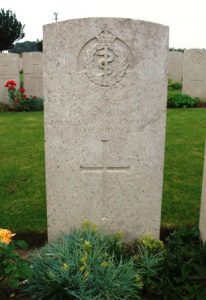
Meirion Morris, Private, 37685, Royal Welsh Fusiliers. Meirion was the son of William and Elizabeth Morris, of Cambrian House, Llanuwchllyn. He worked for the London City and Midland Bank at Wrexham prior to the war, and lived at Peel Cottage, Spring Street. Meirion enlisted at Wrexham into the Royal Welsh Fusiliers on 6 December 1915 and was posted to Kinmel Park for training. Meirion embarked at Folkestone for France on 24 June 1916, and was posted to the 38th Infantry Base Depot at Étaples. He was then posted to the 1st Battalion, Royal Welsh Fusiliers, which was on the Somme attached to 22 Brigade, 7th Division. The Division had taken fought on the opening day of the Somme offensive, on 1 July 1916, taking the village of Mametz, and the 1st RWF had suffered heavy casualties at Bois Francais. The Division had then consolidated its gains to the south of Mametz Wood before moving into reserve to rest. Meirion joined the battalion in tents at Heilly, among a batch of 58 reinforcements on 9 July. The battalion then moved forwards to the Citadel and prepared to relieve the battered 38th (Welsh) Division at Mametz Wood, before preparing to launch an assault on Bazentin-le-Petit. The assault was launched on 14 July, but met with heavy resistance, so fighting raged all day. The battalion then had a brief rest in the remnants of Mametz Wood before moving back into the front line on 19 July 1916, and launching an assault on High Wood. Meirion was killed in action here during the day. The 20-year-old has no known grave and is commemorated on the Thiepval Memorial, France.
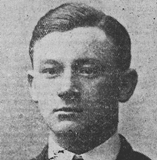
Robert John Morris, Rifleman, 302197, London Regiment. Robert was the son of Morris Edward and Elizabeth Morris, of Plasdeon, Llanuwchllyn. He worked for the National Provincial Bank at Cardiff and at Llanelwy prior to enlisting into the 5th Battalion, London Regiment (London Rifle Brigade) in November 1915. He embarked for France in July 1916, joining the 1/5th Battalion, London Regiment, which was by then attached to 169 Brigade, 56th (London) Division. Robert saw his first major action when the Division took part in the diversionary attack on Gommecourt. The Division then saw heavy fighting during at Ginchy, Flers and Morval, where it captured the village of Combles. The Division wintered in Flanders, before moving to the Arras sector at the beginning of March 1917, and followed the German retreat to the Hindenburg Line that month. By the middle of March the Division was in the line at Beaurains, working on new trenches and posts in terrible wet conditions. Robert was badly wounded here, and died of his wounds on 30 March 1917, aged 23. He is buried in Achicourt Road Cemetery, Achicourt, France.
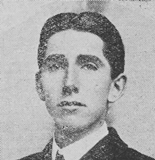
Robert Roberts, Private, 291171, Royal Welsh Fusiliers. Robert was the illegitimate son of Ellen Rowlands (nee Roberts), of Llanuwchllyn. He lived with his wife, Mary Roberts, at 39, Mount Street, Bala. Robert enlisted at Bala into the 3/7th Battalion, Royal Welsh Fusiliers on 29 October 1915. He was posted to Park Hall, Oswestry with the battalion for training. On 21 October 1916 Robert embarked for Egypt, joining the 1/7th Battalion, Royal Welsh Fusiliers. The battalion was attached to 158 Brigade, 53rd (Welsh) Division, and had been evacuated from Gallipoli in December 1915, moving to Egypt to join the EEF, and helped guard the Suez Canal before taking part in operations to drive the Turks out of the Sinai. The EEF then turned its attention onto driving the Turks out of Palestine, and on 26 March 1917 launched its first offensive against the coastal city of Gaza, which guarded the road to Jerusalem. Initial gains during the day were lost when the assaulting divisions lost touch with each other and communication broke down when a thick fog cloaked the battlefield. Robert was wounded during the fighting that day, suffering gunshot wounds to the groin, and was evacuated to the 24th Stationary Hospital at Alexandria where he died of his wounds on 1 April 1917, aged 41. Robert is buried in Kantara War Memorial Cemetery, Egypt. Two of his half-brothers, Ellis Rowlands and Evan David Rowlands, also fell.
William Roberts, Private, 61051, Royal Welsh Fusiliers. William was the son of John and Ann Roberts, of Tyisaf, Llanuwchllyn. He worked as a farm labourer at Tynrhos Farm prior to the war. William married Margaret Davies, Bodiwan, Bala, in 1916. He enlisted at Dolgellau into the Royal Welsh Fusiliers soon afterwards, and was posted to France early in 1917, joining the 15th Battalion, Royal Welsh Fusiliers, which was at Ypres attached to 113 Brigade, 38th (Welsh) Division. The Division had moved there to the Canal Bank sector the previous year, following its efforts at Mametz Wood, and held the line here for almost a year, improving it and carrying out many trench raids, prior to the opening of the Third Battle of Ypres. On 25 July 1917 the 15th RWF was tasked with a trench raid, to gain intelligence prior to the launching of the main attack on 31 July. The German front line was found to be unoccupied, but the raiding party met heavy resistance when advancing to their second line, and suffered a number of casualties. William was 25 years old when he was killed during the raid. He is buried in Artillery Wood Cemetery, Belgium.
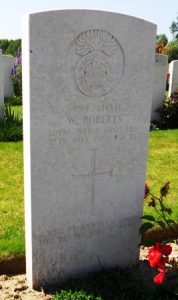
Edward David Rowlands, MM, Private, 2954, Welsh Guards. Edward was the son of Edward and Ellen Rowlands, of Llanuwchllyn. He was the husband of Ellen Rowlands, of Gwesty’r Enyrod, Llanuwchllyn. Edward enlisted at Dolgellau into the Welsh Guards, and after completing his training embarked for France, to join the 1st Battalion, Welsh Guards, which was attached to 3 Guards Brigade, Guards Division. He probably joined the battalion on the Somme among a draft of reinforcements in the summer of 1916, following several costly engagements, namely at the Battle of Flers-Courcelette, and then at the Battle of Morval, where the Guards captured Lesboeufs Village. The Division wintered on the Somme before moving to Ypres later in 1917 and took part in the Battle of Pilckem Ridge, and also in the latter stages of the offensive. By November the Guards had moved south and took part in heavy fighting at the Battle of Cambrai, during the German counter-attack. By now, Edward had been awarded the Military Medal, probably for Pilckem Ridge. The Guards were involved in the heavy fighting which followed the German Spring Offensive of 21 March 1918. On 21 August the Allies launched a general offensive all along the Western Front, and the Guards took part in the advance towards the Hindenburg Line. The Guards saw heavy fighting at the Battle of Havrincourt and at the Battle of the Canal du Nord. Edward was badly wounded near Lagnicourt during the crossing of the Canal, and died of his wounds that day, aged 34. He is buried in Beaumetz Cross Roads Cemetery, Beametz-Les-Cambrai, France. His brother, Ellis, had been killed in 1916, whilst his half-brother, Robert Roberts, had died in 1917.
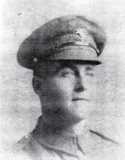
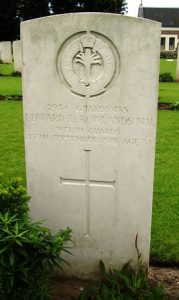
Ellis Rowlands, Private, 447333, Canadian Infantry. Ellis was born on 19 January 1888, the son of Edward and Ellen Rowlands, of Llanuwchllyn. He emigrated to Canada prior to the war and found work as a miner at Calgary. Ellis enlisted at Calgary into the Canadian Expeditionary Force on 24 June 1915, and was posted to the 56th Overseas Battalion, Canadian Infantry. The battalion sailed from Canada for England on 23 March 1916. On 12 May 1916 Ellis was transferred to the 50th Battalion, Canadian Infantry and on 10 August 1916 embarked for France, joining the battalion on the Somme, where it was attached to the 10th Brigade, 4th Canadian Division. The Division saw its first major action on the Somme, during the Battle of Le Transloy, in October, and then in the ensuing Battle of the Ancre Heights, where it took part in the capture of the Regina Trench. The next major offensive for the Division was during the Battle of the Ancre, which was launched on 13 November. On 17 November 1916 the 50th Battalion was located in the Chalk Pits in Sausage Valley, preparing to go over the top the following morning. At dawn on the following morning, the Canadian Artillery opened fire on the German line some 300 yards north of the newly captured Regina Trench, and the battalion began their assault. Little resistance was encountered at first, but a section of German trench had been missed, and fighting intensified. Fighting continued throughout the night and into the following day. Ellis was posted missing during the second day of the fighting, before the battalion was relieved on the night of 19 November 1916. He was later adjudged to have been killed in action on that day. The 28-year-old has no known grave, and is commemorated on the Vimy Memorial, France.
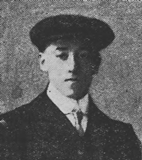
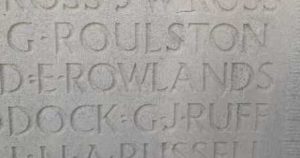
John Francis Rowlands, Lance Corporal, 291737, Royal Welsh Fusiliers. John was the son of John and Catherine Rowlands, of The Eagles, Llanuwchllyn. He ran his own business as a Draper and Grocer at Birmingham House, Llanuwchllyn prior to the war. He enlisted at Bala into the 7th Battalion, Royal Welsh Fusiliers on 10 December 1915, firstly being placed on the reserve, but was mobilised on 20 March 1916 and posted to Kinmel Park for training. After completing his training, John embarked for France on 10 September 1917, and was posted to the 19th Battalion, Royal Welsh Fusiliers on 24 September. The battalion was in the Gonnelieu Sector, near Arras, attached to 119 Brigade, 40th (Bantam) Division and had moved into Brigade Reserve when John arrived with 67 other men to join its ranks. On 8 October the battalion moved into huts at Doingt, and two days later entrained for Beaumetz-les-Loges, and marched to camp at Simencourt. The Division was enjoying a brief spell of rest, so the 19th RWF and the 17th Welsh played a football match at Simencourt, which was won 3-1 by the 19th RWF. Towards the end of the month the more serious matter of training for the forthcoming Battle of Cambrai took precedent, and on 16 November the Division began its move back towards the battle area, reaching Anneux by 22 November. On 23 November 1917 the Division launched its attack on Bourlon Wood, driving its way through to the far edge of the wood, before being caught in a German counter-attack. John was wounded during the fighting in the wood, and died of his wounds on 27 November 1917, aged 36. He is buried in Rocquigny-Equancourt Road British Cemetery, Manancourt, France.
Evan Williams, Private, 42896, Yorkshire Regiment. Evan was the son of Robert and Margaret Williams, of Afonfechan, Llanuwchllyn. He enlisted at Dolgellau into the Royal Field Artillery, but after completing his training was transferred to the 8th Battalion, Yorkshire Regiment. The battalion was in France attached to 69 Brigade, 23rd Division, and Evan probably joined its ranks in the late Summer of 1916. The Division had seen its first major action during the Somme offensive, when it captured the ruined village of Contalmaison, and then fought at the Battle of Bazentin, and the Battle of Pozieres. Evan most likely joined as part of a draft of men to rebuild the 8th Yorks, and would then have taken part in further fighting on the Somme, during the Battle of Flers-Courcelette, the Battle of Morval and the Battle of Le Transloy, where the Division captured Le Sars. In May 1917 the Division took part in the Battle of Messines Ridge. It then enjoyed a brief rest before taking part in the main Passchendaele offensive, and took part in the Battle of the Menin Road. Evan was killed in action at Ypres on 19 September 1917, aged 24. He has no known grave and is commemorated on the Tyne Cot Memorial, Belgium.
Evan Robert Williams, Private, 49699, Royal Welsh Fusiliers. Evan was the son of Evan and Margaret Williams, of Werngoch, Bala. He lived at Abergeirw, Llanfachreth prior to enlisting at Dolgellau into the 7th Battalion, Royal Welsh Fusiliers. The battalion was a Territorial unit, which mobilised for war at Newtown in August 1914, as part of North Wales Brigade, Welsh Division and moved to Conway until the end of the month, before moving to Northampton. In December the Division moved to Cambridge and then in May 1915 to Bedford, where the Division was numbered and the formation became 158 Brigade, 53rd (Welsh) Division. On 19 July 1915 the entire Division sailed from Devonport for Imbros and on 9 August 1915 landed at Suvla Bay. The Division was evacuated from Gallipoli in December 1915, moving to Egypt to join the EEF, and helped guard the Suez Canal before taking part in operations to drive the Turks out of the Sinai. The EEF then turned its attention onto driving the Turks out of Palestine, and on 26 March 1917 launched its first offensive against the coastal city of Gaza, which guarded the road to Jerusalem. At some time after this, Evan was transferred to the 2nd (Garrison) Battalion, Royal Welsh Fusiliers, which was on garrison duty in Egypt. He survived the war, but died of pneumonia in hospital in Alexandria on 12 January 1919, aged 26. Evan is buried in Alexandria (Hadra) War Memorial Cemetery, Egypt.